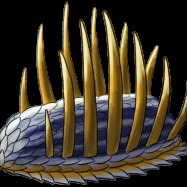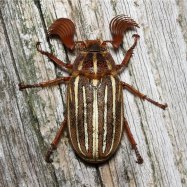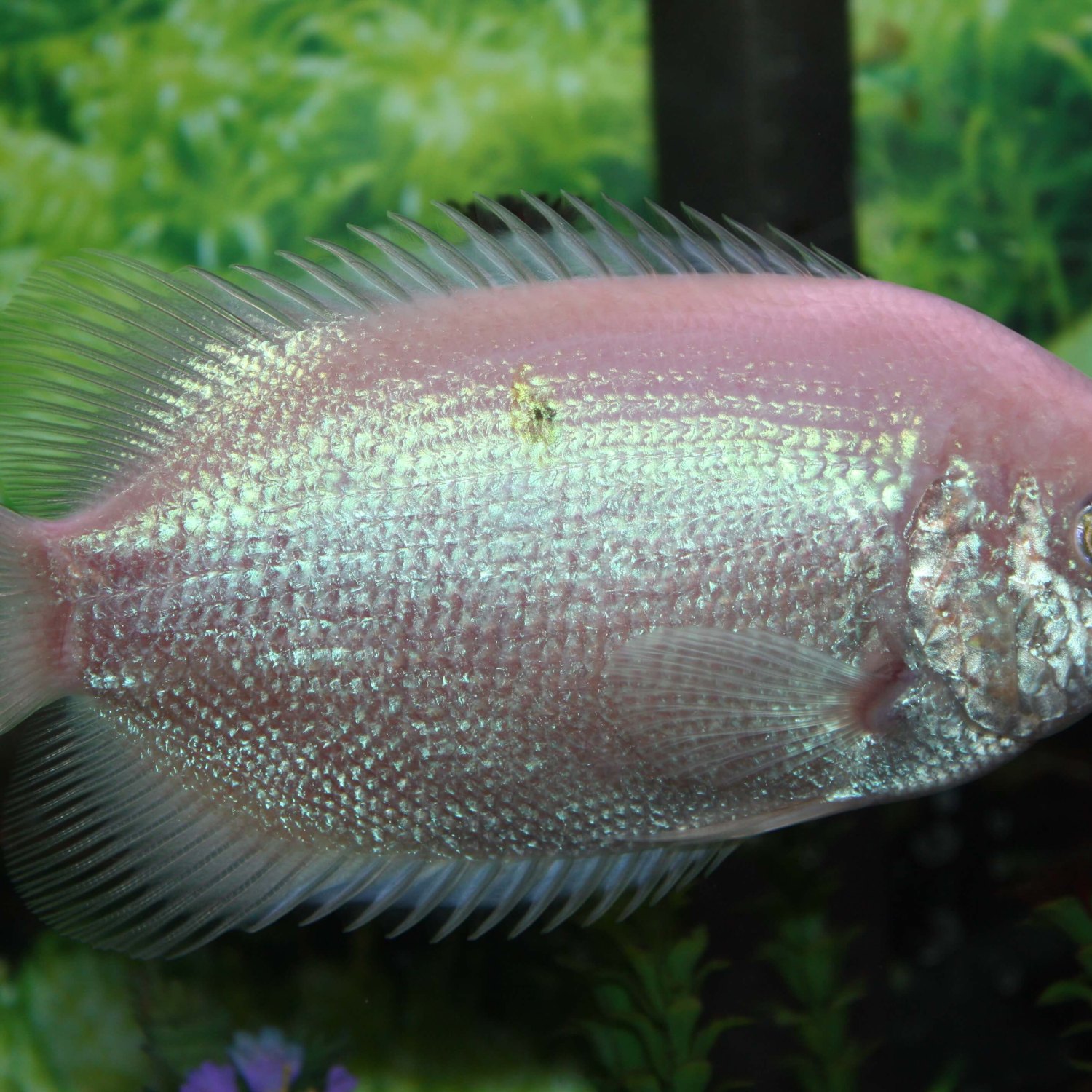
Gourami
10-60 centimeters
Gourami, known for their vibrant colors, can grow up to 60cm in length and can be found in rivers, swamps, and lakes. These peaceful fish belong to the Osphronemidae family and have an oval-shaped, slightly elongated body. Keep these beautiful creatures in mind when planning your next aquarium! #Gourami #AquariumFish #Osphronemidae
Animal Details Summary:
Common Name: Gourami
Kingdom: Animalia
Habitat: Freshwater
The Fascinating World of Gourami Fish
Deep in the freshwater bodies of Southeast Asia, a stunning species of fish roams its watery home. With a scientific name of Osphronemus, these fish are more commonly known as Gourami. These fish are a favorite among aquarium enthusiasts for their exotic appearance and countless fascinating characteristics. In this article, we will delve into the world of Gourami fish and uncover the unique features that make them stand out in the vast underwater kingdom Gourami.The Kingdom of Gourami
Gourami fish belong to the Kingdom Animalia, which encompasses all living organisms that are made up of cells and have the ability to move. As part of the Chordata phylum, Gourami fish are identifiable by their spinal cord and backbone. They are further classified under the Class Actinopterygii, which includes all ray-finned fish such as salmon, trout, and tuna. Gourami fish also belong to the Order Perciformes, which comprises almost 40% of all fish species. Interestingly, the name Perciformes is derived from the Greek word "perke," meaning perch.The Family of Osphronemidae
Gourami fish belong to the Osphronemidae family, named after their scientific name Osphronemus. This family includes several other fish species, such as the Betta fish and Paradise fish. Osphronemidae is a diverse family, with species found in various regions, from Asia to Africa. However, Gourami fish claim their origin in Indonesia, specifically in the many rivers, swamps, and lakes that are scattered across the country Groundhog.The Distinct Habitat of Gourami Fish
As mentioned earlier, Gourami fish are native to the freshwater bodies of Southeast Asia, particularly in Indonesia. They can also be found in other countries in the region, such as Malaysia, Thailand, and Vietnam. In their natural habitat, these fish prefer areas with slow-moving or still water, typically near the shore. The vegetation in these freshwater bodies is vital for the survival of Gourami fish as they use the plants for shelter and breeding.Feeding Method of Gourami Fish
Gourami fish are omnivores, meaning they consume both plants and animals. In their natural habitat, they feed on a variety of small insects, larvae, and freshwater crustaceans. However, in captivity, they can be fed a mix of commercial flaked, pelleted, or frozen food, along with fresh vegetables and fruits. These fish have small, narrow jaws, which allow them to nibble on small pieces of food, making them efficient foragers.The Colorful World of Gourami Fish
One of the most striking features of Gourami fish is their vibrant coloration. Depending on the species, these fish can come in a range of colors, including silver, gold, blue, red, and even a combination of these colors. Some species also have beautiful patterns, such as stripes or spots, adding to their overall visual appeal. The coloration of Gourami fish is not only for aesthetic purposes but also serves as a form of communication and camouflage in their natural habitat.The Distinctive Body Shape of Gourami Fish
Another standout feature of Gourami fish is their body shape. These fish have an elongated, oval-shaped body, which is slightly compressed on the sides. This body shape allows them to navigate through dense vegetation in their natural habitat with ease. Additionally, their elongated body shape also makes them excellent jumpers, allowing them to escape predators or access food above the water's surface.The Length of Gourami Fish
Gourami fish can vary in size, with some species growing up to 60 centimeters in length, while others can be as small as 10 centimeters. However, in captivity, the average size of Gourami fish is between 15-20 centimeters. When considering adding Gourami fish to your aquarium, it's essential to research the species you plan to keep to ensure you have enough space to accommodate their size.The Social Behavior of Gourami Fish
Gourami fish exhibit fascinating social behavior, making them a popular choice amongst aquarium enthusiasts. They are generally peaceful fish and thrive in small groups, making them suitable for a community aquarium. However, it's essential to note that they can also be territorial, especially during breeding and nesting. In such instances, it's best to limit the number of males in the tank to prevent any aggressive behavior.The Peaceful Nature of Gourami Fish
Despite their territorial instincts, Gourami fish are generally known for their peaceful nature. They are a great addition to a community tank, and their calm demeanor makes them perfect for beginners in the aquarium hobby. However, it's crucial to provide them with ample space and hiding spots, especially during breeding, to prevent any conflicts.Understanding the Fascinating World of Gourami Fish through NLP
Natural Language Processing (NLP) is an AI-powered technology that enables computers to analyze, understand, and generate human language. Through NLP, we can gain a deeper understanding of the features and characteristics of Gourami fish. By breaking down the data summary, we can see that Gourami fish belong to the Kingdom Animalia, further classified under the phylum Chordata, class Actinopterygii, and order Perciformes. They are part of the Osphronemidae family, are native to Southeast Asia, and have an omnivorous feeding method. The colorful and distinctive features of Gourami fish make them stand out in the vast underwater world, and their social and peaceful behavior makes them a popular choice for aquariums.The Importance of SEO in the World of Gourami Fish
SEO (Search Engine Optimization) is crucial for any website or blog to attract more readers and rank higher in search engine results. When writing about Gourami fish, using keywords such as "Gourami" and "Osphronemus" can help your article appear in relevant searches. Other important keywords include "freshwater fish," "aquarium," and "Southeast Asia." By using these keywords naturally throughout your article, you can increase its discoverability and reach a broader audience interested in Gourami fish.Conclusion
In conclusion, Gourami fish are a fascinating species that have captured the interest of many aquarium enthusiasts. From their vibrant coloration and unique body shape to their peaceful and social behavior, these fish are a joy to observe and care for. Through NLP and SEO, we can gain a better understanding of the unique features of Gourami fish and share this knowledge with others who share our love for these beautiful creatures. So, if you're looking to add some color and charm to your aquarium, consider bringing in a Gourami fish and experience the wonders of the underwater world.

Gourami
Animal Details Gourami - Scientific Name: Osphronemus
- Category: Animals G
- Scientific Name: Osphronemus
- Common Name: Gourami
- Kingdom: Animalia
- Phylum: Chordata
- Class: Actinopterygii
- Order: Perciformes
- Family: Osphronemidae
- Habitat: Freshwater
- Feeding Method: Omnivorous
- Geographical Distribution: Southeast Asia
- Country of Origin: Indonesia
- Location: Rivers, swamps, and lakes
- Animal Coloration: Varies depending on the species, including shades of silver, gold, blue, or red.
- Body Shape: Oval-shaped and slightly elongated
- Length: 10-60 centimeters
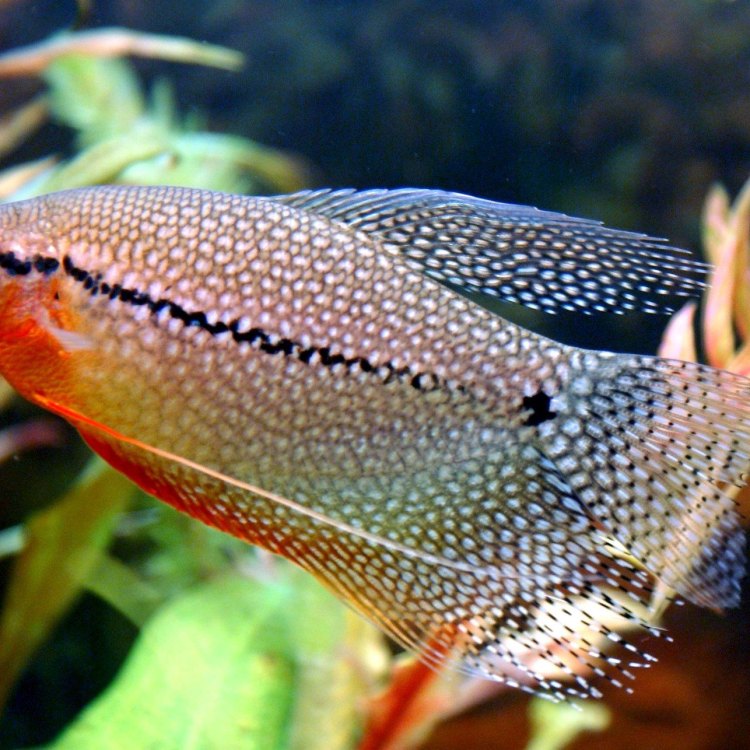
Gourami
- Adult Size: Depends on the species, ranging from small (10-15 centimeters) to large (40-60 centimeters)
- Average Lifespan: 5-8 years
- Reproduction: Sexual
- Reproductive Behavior: Bubble nest building and paternal care
- Sound or Call: Varies depending on the species
- Migration Pattern: Non-migratory
- Social Groups: Solitary or in small groups
- Behavior: Generally peaceful, but can be territorial
- Threats: Habitat destruction, overfishing, pollution
- Conservation Status: Varies depending on the species, some are listed as vulnerable or endangered
- Impact on Ecosystem: Keystone species in some habitats
- Human Use: Ornamental fish trade
- Distinctive Features: Facial whiskers and long dorsal and anal fins
- Interesting Facts: Gouramis are labyrinth fish, meaning they have a specialized breathing organ called a labyrinth organ that allows them to breathe air directly from the surface. They can survive in low-oxygen environments.
- Predator: Predators can include larger fish and birds
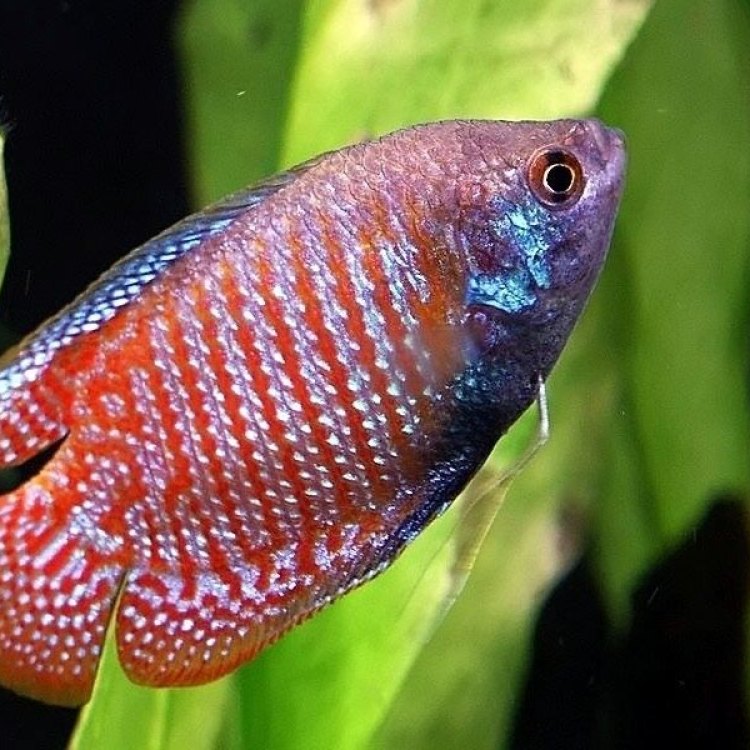
Osphronemus
The Fascinating World of Gouramis - A Unique Species of Fish
When it comes to pet fish, most people often think of cute and colorful little creatures swimming around in an aquarium. But there is one particular species of fish that stands out among the rest - the Gourami. These beautiful fish are not only visually stunning but also possess unique characteristics that make them stand out in the aquatic world.Gouramis, also known as gouramies, are a diverse group of freshwater fish that belong to the Osphronemidae family PeaceOfAnimals.Com. There are over 130 different species of Gourami, and they can be found in various parts of Asia, from India to Southeast Asia. They are popular among fish enthusiasts for their striking appearance, peaceful nature, and interesting behavioral traits.
However, beyond their appeal as pets, Gouramis play a crucial role in their natural habitats and are considered a keystone species in some ecosystems. In this article, we will delve into the fascinating world of Gouramis and uncover the unique features and behaviors that make them a favorite among fish lovers.
A Glimpse into Gourami's Physical Characteristics
Gouramis come in a wide range of sizes, colors, and patterns, making them a popular choice for aquariums. Depending on the species, they can range from small, as little as 10-15 centimeters, to large, up to 40-60 centimeters in adulthood. They have a long, slender body with a distinctly pointed head, and their most prominent feature is their long dorsal and anal fins. These fins give them an elegant appearance as they gracefully glide through the water.One of the most prominent physical characteristics of Gouramis is their facial whiskers Gypsy Moth. These sensory organs, also known as barbels, are used for detecting food and navigating in dark and murky water. They also have a unique feature called labyrinth organ, which allows them to breathe air directly from the surface. This special organ makes them a hardy species, capable of surviving in low-oxygen environments where other fish would not.
A Glimpse into Gourami's Behavior and Reproduction
Gouramis are fascinating creatures with complex social behaviors. They are generally solitary but can also be found in small groups in the wild. They are peaceful fish, but certain species can be territorial, especially during breeding season.Speaking of breeding, Gouramis reproduce sexually, and their reproductive behavior is quite fascinating. The male Gourami is responsible for building a bubble nest using bubbles secreted from his mouth. Once the nest is complete, the female will lay her eggs, and the male will carefully tend to them until they hatch. He will vigorously protect the eggs and fry until they are old enough to fend for themselves. This unique paternal care behavior is not commonly found in the animal kingdom, making Gouramis even more intriguing.
The Distinctive Sounds of Gouramis
If you've ever been near a fish tank and heard some strange sounds, chances are they were coming from a Gourami. Unlike most fish, some species of Gourami can produce sounds using their swim bladder. These sounds, also known as croaking or grunting, vary depending on the species and are a form of communication. They can indicate aggression, courtship, or simply establish dominance in their social hierarchy.The ability to produce sounds is most commonly seen in male Gouramis during the mating season. They will emit these sounds to attract females and defend their territory from other males.
Gouramis in the Wild - Their Habitat and Threats
Gouramis are predominantly found in slow-moving or stagnant waters such as ponds, lakes, and streams, usually with dense vegetation cover. They are non-migratory fish, so they remain in the same area throughout their lifespan.However, their natural habitats are under threat due to human activities such as habitat destruction and pollution. In some areas, they are also overfished for food, which has led to a decline in their populations. Some species of Gouramis are listed as vulnerable or endangered on the IUCN Red List, highlighting the need for conservation efforts to protect these unique creatures.
The Unique Role of Gouramis in Ecosystems
Gouramis may be small in size, but they play a significant role in their natural habitats. In many ecosystems, they are considered a keystone species, meaning they have a disproportionate effect on the ecosystem's overall function. For example, Gouramis in their wild habitats feed on various aquatic insects and other small creatures, and in turn, they become prey for larger fish and birds. Therefore, their presence or absence can significantly impact the balance of the food chain.In addition, Gouramis also contribute to the health of their habitat by eating excess plant material and controlling algae growth, making them valuable in sustaining a diverse and healthy ecosystem.
Human Use and Captivity
Gouramis have been popular in the ornamental fish trade for many years, making them one of the most widely kept aquarium fish. They are peaceful and easy to care for, making them a great addition to any fish tank. However, their popularity has also led to over-harvesting in the wild, further threatening their populations. It is essential to only purchase Gouramis from reputable breeders to ensure that they are not contributing to the depletion of wild populations.In captivity, Gouramis can live up to 5-8 years, provided they are given proper care and a suitable environment. They thrive in aquariums with plenty of vegetation and hiding places, as well as a well-maintained water quality. It is also important to keep them in groups with compatible tank mates to prevent aggression.
The Predator-Prey Relationship of Gouramis
Like most animals, Gouramis have their share of predators in the wild. Their predators can include larger fish, birds, and other aquatic animals. However, their unique ability to breathe air from the surface gives them an advantage, as they can hide in shallow water or even leave the water completely in times of danger.The Fascinating World of Gouramis - In Conclusion
In summary, Gouramis are a diverse and fascinating species of fish, popular both in the wild and in captivity. Their unique physical characteristics, behaviors, and social dynamics make them stand out among other fish. However, they are also facing threats that require conservation efforts to protect their populations and their crucial role in various ecosystems.As we continue to learn more about Gouramis and their impact on the world around us, it is essential to appreciate and respect these creatures as vital members of their environment. They are a true testament to the beauty and complexity of nature, and it is up to us to ensure their preservation for future generations to admire and learn from.
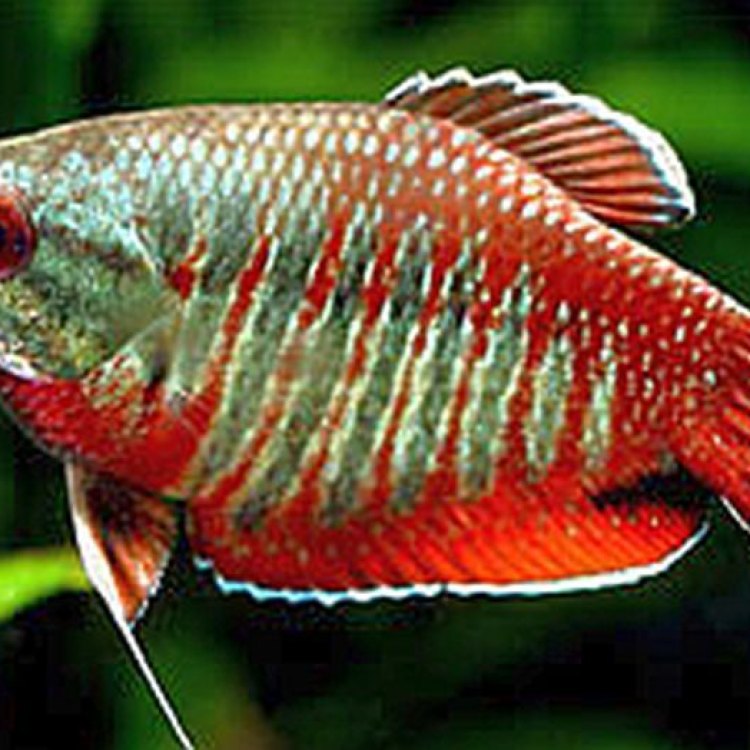
The Fascinating World of Gourami Fish
Disclaimer: The content provided is for informational purposes only. We cannot guarantee the accuracy of the information on this page 100%. All information provided here may change without prior notice.




